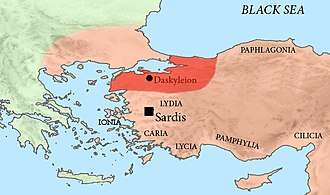Megabazus
Megabazus (Ancient Greek: Μεγαβάζος), son of Megabates, was a highly regarded Persian general under Darius, of whom he was a first-degree cousin. Most information about him comes from The Histories by Herodotus.
Megabazus | |
|---|---|
.jpg) Megabazus was son of Megabates.[1] | |
| Native name | Bakabadus |
| Allegiance | Achaemenid Empire |
| Battles/wars | European Scythian campaign of Darius I Darius' Thracian campaign Unknown others |
| Children | Megabates[2] Oebares II Bubares Pherendates[3] |
| Relations | Megabates (father) |

Scythian campaign (513 BC)
Megabazus led the army of the Great King Darius I in 513 BC on the European Scythian campaign of Darius I. After this had to be discontinued without result, Megabazos was left as commander-in-chief of an 80,000-man army in Europe, with the mission to subjugate the Greek cities on the Hellespont. The Persian troops subjugated gold-rich Thrace after capturing Perinthos, the coastal Greek cities, and defeated the powerful Paeonians, whom he deported to Phrygia.[6][7]
Subjugation of Macedonia
Finally, Megabazus sent envoys to Amyntas I, king of Macedon, demanding acceptation of Persian domination, which the Macedonian accepted.[8][9] Megabazus received the present of "Earth and Water" from Amyntas, which symbolized submission to the Achaemenid Emperor.[10] Amyntas then acted as hyparch to Darius I.[11]
Disagreements came when the members of the Persian delegation insulting the Macedonians by meddling with their wives. Prince Alexander I reacted this by murdering several Persian diplomats and their followers. The conflict was later settled by the marriage of Megabazos' son, Bubares, with the Macedonian princess Gygaia, daughters of Amyntas, possibly as a way of reinforcing the alliance.[10] Bubares was one of the sons of Megabazus.[12]
After his return to Asia Minor, Megabazus received the governorship of the province (satrapy) of Hellespontine Phrygia in its capital Daskyleion.
Rivality with Histiaeus
Megabazus was suspicious of Histiaeus, Tyrant of Miletus, and advised Darius to bring him to Susa to keep a closer eye on him. His suspicions turned out to be true as Histiaeus provoked a revolt in the town he was formally in charge of and later sided with the Greeks against Persia. The successor to Megabazus's command was Otanes (son of Sisamnes).[13]
According to Herodotus (Herodotus 6.33) Oebares was a son of Megabazus, and became satrap of Daskyleion (Hellespontine Phrygia) in 493 BC.[14][12]
Megabates was another son of Megabazus. He was a commander of the Achaemenid fleet that sailed against Naxos in 500/499 BC. He also was Satrap of Daskyleion in the early 470s.[12][15]
Sons
- Oebares: becomes Satrap of Daskyleion circa 493 BC
- Bubares: Engineer of the Athos Canal of Xerxes I
- Megabates: Fleet Commander and Satrap of Daskyleion
- Pherendates: died around 485 BC as satrap of Egypt.
References
- DASCYLIUM – Encyclopaedia Iranica Table 3.
- https://www.livius.org/articles/person/megabazus/
- http://asiaminor.ehw.gr/Forms/fLemmaBody.aspx?lemmaId=7970#noteendNote_10
- Darius I, DNa inscription, Line 29
- Adams 2010, pp. 343–344
- "A Companion to Ancient Macedonia". Retrieved 17 December 2014.
- "Persian influence on Greece (2)". Retrieved 17 December 2014.
- "A Companion to Ancient Macedonia". Retrieved 17 December 2014.
- "Persian influence on Greece (2)". Retrieved 17 December 2014.
- Waters, Matt (2014). Ancient Persia: A Concise History of the Achaemenid Empire, 550–330 BCE. Cambridge University Press. p. 83. ISBN 9781107009608.
- King, Carol J. (2017). Ancient Macedonia. Routledge. p. 27. ISBN 9781351710329.
- DASCYLIUM – Encyclopaedia Iranica.
- Perseus Under Philologic: Hdt. 5.25.1.
- LacusCurtius • Herodotus — Book VI, 33.
- Thucydides, 1.129; Herodotus, 5.32-35, 6.32

